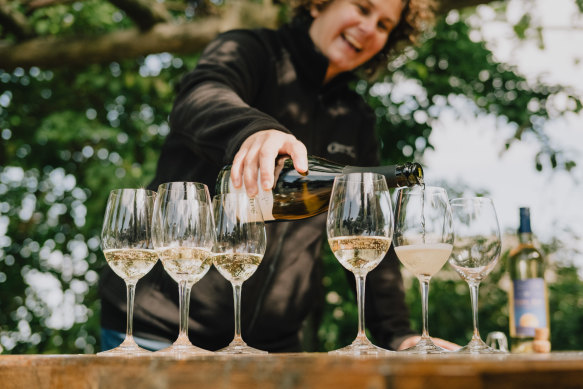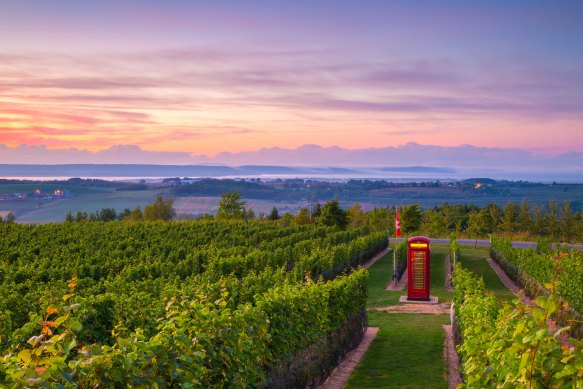This burgeoning wine region has an unusual secret weapon
Visitors to the Bay of Fundy have two main options. Find a vantage point and watch the tide pour in or arrive at low tide and walk on the exposed ocean floor. While the bay wears its “highest tides in the world” badge well, there’s something else stirring in this stretch of water between the Canadian provinces of New Brunswick and Nova Scotia. Something the international wine industry is starting to take notice of.

Unique Nova Scotia wines at Domaine de Grand Pre.
“The rising and falling tides release minerals from the ocean floor into the air,” explains JD Goossens, handing out tasting glasses of a Luckett Vineyards 2022 Tidal Bay. “Over time, these deposits have settled in the soil creating a unique terroir for growing grapes.”
I’ve joined Grape Escapes for a full-day of wine tasting in the Annapolis Valley, an easy one-hour drive from Halifax, the capital of Nova Scotia. Led by JD Goossens, a graduate of the Canadian Association of Professional Sommeliers, we’ll visit three wineries and learn about the new appellation known as Tidal Bay.
“Tidal Bay was created to reflect the coastal breezes and cool-climate characteristics of the region,” says Goossens. “Launched in 2012 Tidal Bay is the first wine appellation for Nova Scotia.”
To receive the designation, a Tidal Bay wine must be made from 100 per cent Nova Scotian-grown grapes using specific varieties such as cool climate L’Acadie. It must demonstrate the signature Nova Scotia profile; light in body, dynamic acidity, characteristic mineralogy, and most importantly, pair well with seafood.
“It’s really starting to boom,” says Goossens. “Out of 24 wineries, 14 are now producing a Tidal Bay vintage.”
We start at Luckett Vineyards, where the standout red is a British phone booth peeping through the vines like a wayward piece of pop art. No, it’s not my jet-lagged brain playing tricks, but an invitation by the Luckett family to phone home (for free within North America). After sampling three wines we round out our visit with an included lunch, paired with a glass of Tidal Bay, in the private cellar room.

A phone box in a slightly unusual setting.
We finish our tasting with a 2021 Phone Box red while overlooking the vineyards. In the distance, the Bay of Fundy glows like quicksilver, its silken surface belying its power to move sea water through a vertical tidal range of 16 metres.
Our next stop is Domaine de Grand Pre, the region’s oldest winery. Here we taste a 2021 Tidal Bay made from a blend of five varieties: L’Acadie blanc, seyval blanc, vidal blanc, ortega, and New York muscat. As we sip, we learn that the L’Arcadie grapes are a complex hybrid named after the Acadians who settled and grew grapes here 400 years ago.
“Unfortunately, they were expelled from Canada in the 1700s when they refused to declare loyalty to Britain,” says Goossens.
Driving through Wolfville we learn more about this French connection, from the ingenious dykes, where these early settlers reclaimed farmland from marshes, to the Grand-Pre National Historic Site, which was once the centre of Acadian life from 1682 to 1755.
Our last stop is Benjamin Bridge, a small producer that is making a big splash in the world of sparkling wine. The NV brut is a summer delight, but it’s the Glooscap First Nation rosé I’m drawn to. Created in collaboration with the Indigenous Mi’kmaq people, who have lived on this land since time immemorial, this wine embodies the friendship between the winery and the traditional owners.
A portion of profits from the rosé goes directly towards supporting community activities such as scholarships for local First Nations students. “In a further bold move the winery has set aside 30 acres [12 hectares] out of its 100 acres [40 hectares] for the growth of native species rather than the cultivation of grapes,” says Goossens.
We raise our glasses, to the tides that have created such a unique terroir, but also to the lives of the people who have tilled this soil for countless generations before us. As Goossens says, “it’s the taste of Nova Scotia in a glass”.
THE DETAILS
FLY
Canada Airways operates flights from Sydney to Vancouver with connections to Halifax, Nova Scotia. See aircanada.com
TOUR
Grape Escapes Nova Scotia Wine Tours offers group and private tours to the Annapolis Valley from Halifax or Wolfville from $C151 ($172). See novascotiawinetours.com
The writer was a guest of Destination Canada and Atlantic Tours and Travel.
Sign up for the Traveller Deals newsletter
Get exclusive travel deals delivered straight to your inbox. Sign up now.